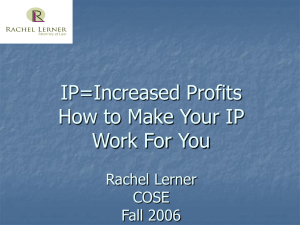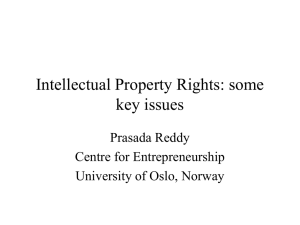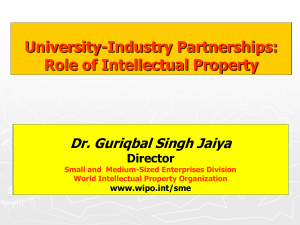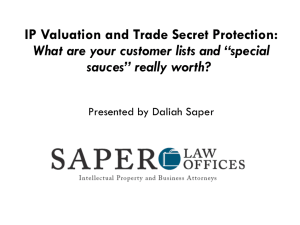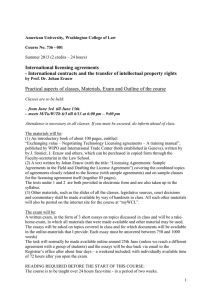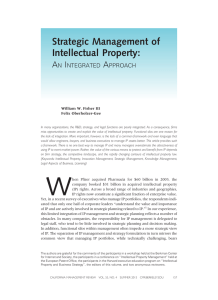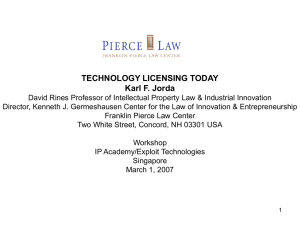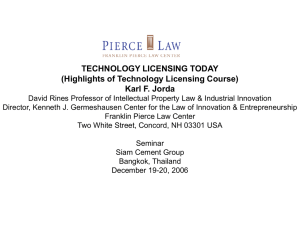Exploiting Intellectual Property Assets
advertisement
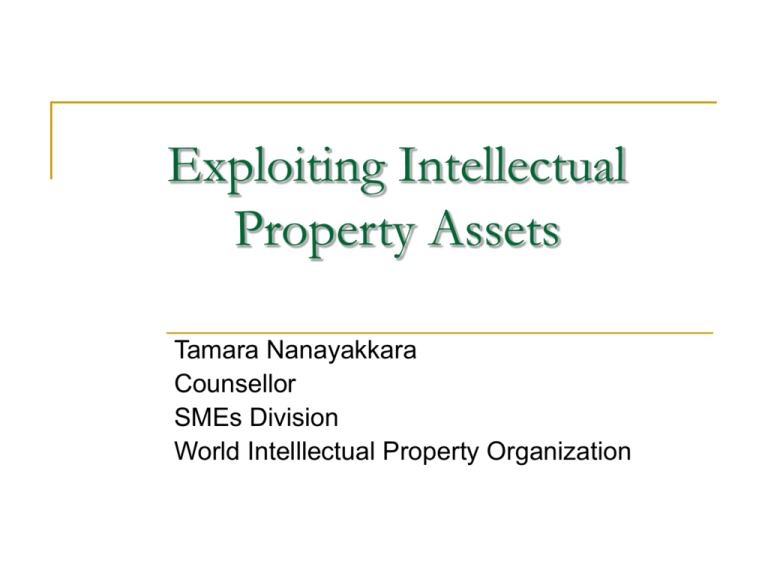
Exploiting Intellectual Property Assets Tamara Nanayakkara Counsellor SMEs Division World Intelllectual Property Organization Summary Slide New Economy Intellectual Property and Competitiveness Intellectual Property Assets Exploiting IP assets New Economy New economy or the knowledge economy – Greater reliance on know-how, knowledge, human creativity and innovation (infinite) “It is estimated that by 2007, as much as 90% of the value of the world’s top 2000 enterprises will consist of intellectual property” Price Waterhouse Coopers The amount of market value that cannot be traced to tangible assets on the corporate books. , Japanese IP Typhoon Still Not Even a Tropical Storm! (II), Terry Ludlow IP frontline.com, Feb 2008 New Economy Global market place Demanding and fickle consumers Shorter product cycles Working through relationships, networks and outsourcing Increased competition Pressure to do more with less IP and Competitiveness Design Source Reputation Innovative features Quality Intellectual Property and Competitiveness The intangibles that add value and differentiate a product are protected by IP The IP system provides exclusivity over the exploitation of innovative products and services, creative designs and business identifiers Exclusivity means that an owner of IP has the right to prevent anyone else from using and exploiting the IP right Intellectual Property Assets Innovative products/ processes Cultural, artistic and literary works Copyright and related rights Goods that have a certain quality or reputation due to where it comes from Creative designs Distinctive signs Confidential business information Patents or utility models Geographical Indications design rights Trademark Trade secrets Patents A product or process providing a new way of doing something, or a new technical solution to a problem (which may lower cost, create efficiencies, enhance performance, add new features etc..) If it is new, not obvious and has industrial applicability it could be granted a patent which would provide an exclusive right to prevent others from using the invention for a maximum period of 20 years Trademarks A sign that distinguishes the goods and services of one enterprise from that of another Right to prevent others from using identical or similar marks with respect to goods or services that are identical or similar Rights obtained through registration (or use) Famous marks have greater rights Design Rights The ornamental or aesthetic aspects of a product, that which distinguishes that product from the competition and makes the product appealing to a consumer Right to prevent others from using identical or similar designs Rights obtained by registration but in some countries there exists an unregistered design right Geographical Indications Goods that have a certain quality or reputation due to the geographical region it comes from Generally pertaining to agricultural products Examples: Bordeaux wine, Ceylon tea, Gruyere cheese, Swiss chocolates, Champagne, Colombian coffee, Greek feta cheese Copyright Copyright law grants authors, composers, and other creators legal protection for their creations usually referred to as “works.” From a business point of view these will include computer programs or software, content on websites, catalogs, newsletters, manuals, artwork and text on product literature, labels or packaging, posters etc, It gives an author or creator economic rights to control the economic use of his work and moral rights to protect his reputation and integrity. No registration required to obtain rights Trade Secret If reasonable steps have been taken to keep certain information secret and it has commercial value by virtue of being secret it may qualify for trade secret protection Use of confidentiality agreements, physical barriers to access to information and a HR policy that values and protects the confidential information of the business Exploiting IP Assets The right to prevent a third party from using and exploiting the IP right vests in the owner an asset not very different to a physical asset, such as a car or a house Like physical assets, IP assets could be creatively and profitably exploited Exploiting IP assets Core to the competitiveness of the product or service Other options Sale, license, franchise or merchandise Joint ventures and strategic alliances Defensive patenting, publication Finance Core to the product or service Copyright – ring tones, games, software Trademark – Nokia connecting people, signature tune Patent – over 10,000 patented inventions, caller name display and caller specific ring tone two nokia patents used by most phones, industry standard technologies. Nokia, Ericsson and Motorola account for more than 60% of the industry's R&D – significant entry barriers Design – shape, look, keypad etc. The mobile phone has become a status icon, making the product design critical in the purchase decision Trade secret – all of the know-how and confidential business practices that went into the manufacture of the device Licensing Licensing is when an owner of such an intangible asset, transfers the right to use that asset to another, for a price, while retaining ownership of that asset. Licensing The inventor licensed the system to Coca-Cola at 1/10 of a penny per can. During the period of validity of the patent the inventor obtained 148,000 UK pounds a day on royalties Franchise A specialized license where the franchisee is allowed by the franchisor in return for a fee to use a particular business model and is licensed a bundle of IP rights (TM, service marks, patents, trade secrets, copyrighted works…) and supported by training, technical support and mentoring Merchandising The licensing of trademarks, designs, artworks as well as fictional characters (protected by these rights) and real personalities are broadly referred to as merchandising Defensive Patenting and Cross Licensing Where a product has a multitude of technologies integrated in it covered by patents owned by different owners access to each others' technologies is necessary. Here the different companies will cross license each other rather than sue each other. Offensive patent is one that license revenue is ensured as the other party does not have a patent and defensive one is when the other party has one and then you cross license each other. Strategic Alliances Easier to enter into alliances when you have a strong IP portfolio Publication By publishing, the invention is no longer new and not patentable. Decide not to patent and prevent others from patenting Finance As assets they could be pledged as a collateral for a bank loan Angel investors and Venture Capitalists are inclined to invest in companies that have a good IP portfolio


